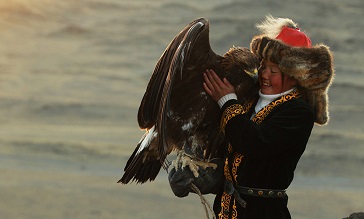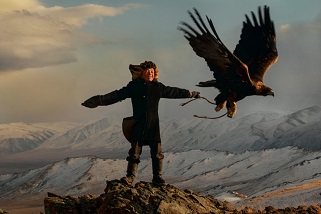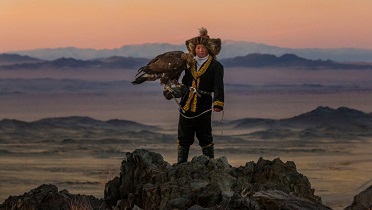Russia and China Are Making Mongolia a Key Part of Their Integration
Mark Goleman
Instead of competing, as in the past, the three countries are now closely coordinating development of this key strategic country. Massive infrastructure projects: rail, roads, pipelines, electricity.
This article first appeared in New Eastern Outlook under the title: "The Triangle: Russia, Mongolia, China". The political relationship between Russia and Mongolia is actually much longer than this article suggests. Mongolia was the world’s second Communist state, adopting Communism in 1921 shortly after it broke away from China. Thereafter the USSR and Mongolia had extremely close relations until the USSR’s collapse. In 1939 the two countries fought together against the Japanese who they defeated in the famous battle of Khalkin Gul. Mongolia also fought alongside the USSR during World War II. The article nonetheless gives a good overview of relations today and of the way in which from being competitors for influence in Mongolia China and Russia have become partners as their own relations have converged.
In 1994, the State Great Khural, Mongolia’s supreme organ of government authority, adopted a foreign policy concept emphasizing development of good-neighborly, constructive relations with Russia and China as a priority for the foreign policy of Mongolia.
Up to that point, Mongolian-Russian and Mongolian-Chinese relations had proceeded through several stages of development, experiencing both ups and downs.
In the first decade following the establishment of the People’s Republic of China, Beijing and especially Moscow proved to be a big help to Mongolia. China offered assistance in construction of residential areas in Ulan Bator, the broad iron-and-concrete bridge over the Tuul River, the Ulan Bator Hotel, the Central Department Store and so forth. The Soviet Union helped to build the city of Darkhan and the surrounding industrial complex, as well as put into operation the Erdenet copper mine, the Sharyngolvskiy coal mine and thermoelectric plants No. 3 and No. 4 in the capital, and more.
Western analysts say that the reason underlying the generous amounts of aid that flowed from both countries during that period was the struggle between the Soviet Union and China for dominance in Mongolia.
All of that lasted until the second half of the 1960s, when relations between Mongolia and China fell apart because of the confrontation that had arisen between China and the Soviet Union. Over the ensuing 20 years, the relationship between Mongolia and China was practically reduced to nil, not the least because Mao Zedong and his minions made no secret of their aspirations to make Mongolia part of China. Against this backdrop, over that time the Soviet Union remained Mongolia’s primary sponsor and inspiration in “the cause of building socialism”.
A five-year trade agreement signed between Mongolia and China in 1986 initiated normalization and warming of political relations between the two countries, which was accompanied by a boost in trade and economic ties from 1990 to 1993. Eventually, it led to signing of a fundamental treaty on amicable relations and co-operation between Mongolia and China. The deal was signed on April 29, 1994 as a result of Chinese Premier Li Peng’s visit to Ulan Bator.
All of that took place amid a sharp decline in Mongolian-Russian relations from 1990 to 1992. The decline was prompted by a sequence of objective and subjective reasons, and was stopped by the signing of a primary treaty on friendship and cooperation in 1993. It’s worth noting, that China adroitly took advantage of the decline in relations between Mongolia and Russia to enhance its standing on the Mongolian market.
The period from 1993-94 to 2000 was characterized by full stabilization of relations between Russia and Mongolia and by advancement of China as Mongolia’s major trading and economic partner.
The beginning of the 21st century marked the onset of the current phase of Mongolia’s relations with Russia and China, the key feature of this new phase being the transition from comprehensively growing bilateral cooperation to strategic partnership and advancement of an agenda aimed at establishing and enhancing the trilateral cooperation.
Clearly, the necessary first step in that direction is for Russia, Mongolia and China to reach a consensus on the basic premises for such partnership. A special meeting held at the urging of Mongolian President Tsakhiagiin Elbegdor served those aims. Mr. Elbegdor met with Russian President Vladimir Putin and Chinese President Xi Jinping on September 12 during the 14th summit of the Shanghai Cooperation Organization in Dushanbe.
For the first time in recent memory, the leaders of Mongolia, Russia and China got together and sat down at the negotiating table to share their views on Mr. Elbegdorj’s offer to hold a trilateral summit in order to discuss the cooperation matters as well as the outlook for the broader cooperation and the security issues in northeast Asia. It stands to mention that the idea of holding the so-called three-party Ulan Bator Dialogue had been on Mr. Elbegdorj’s mind for a while. The concept was ventilated in the recent negotiations with Xi Jinping during the Chinese president’s state visit to Mongolia on August 21-22, and during Mr. Putin’s working visit on September 3, 2014. Already back then the proposal received a warm welcome, and in Dushanbe the three leaders expressly voiced their complete approval of this initiative, hence making the Dushanbe meeting an important political mile stone.
The Mongolian president offered three principles to serve as a basis for organizing the top-level trilateral summit: 1.) The three-party meeting shall be held once every three years, while the deputy foreign ministers of the three countries shall meet annually in Ulan Bator for the preparation of the summit 2.) The Ulan Bator Dialogue shall be open to the public and shall be congruent with the general principles of the trilateral partnership 3.) The summit shall address questions pertaining to the interests of all three parties, including transportation, infrastructure and regional issues. Reflecting Mongolia’s vested interest in boosting rail shipments and construction of a gas pipeline from Russia to China across western Mongolia, special emphasis was placed on the potential for the country to bring in significant revenue from the transit. Taking the circumstances into account, Mr. Elbegdorj proposed that the three countries hold a work session this year in Ulan Bator for discussion and resolution of the above issues. He said that the work session would “jump-start cooperation not just among the three countries, but also in the whole region as well.”
Mr. Elbegdorj has made it obvious in his public remarks and his proposals that Mongolia is striving to play the leading role in the three-party dialogue, or a very active one in any case, and to be the nucleus of the trilateral negotiations.
During the meeting in Dushanbe, Russia and China registered their attitude to the Mongolian proposal in statements by their respective leaders, and supported the idea of holding such a summit. Putin’s words were “we believe that establishing an ongoing dialogue is an important, reasonable and valuable task”. Xi Jinping expressed confidence that the three-way meeting “would provide a solid basis for development of closer relations between the three parties in the future.”
Among other matters, the leaders of Russia and China demonstrated their complete willingness to support Mongolia’s membership bid to the Asia-Pacific Economic Cooperation group at the organization’s summit in Beijing in November, 2014.
However, there has been some disagreement on where and when the summit should be held. Mr. Putin’s opinion was that the three-sided dialogue could be held at the annual summit of the Shanghai Cooperation Organization (the next summit of SCO is held in July 2015 in Ufa, the capital of Bashkortostan). Xi Jinping, in his turn, spoke in general terms of the importance of an initial three-sided meeting, without commenting on the time and venue for the meeting and without mentioning whether any further meetings are to be held after the initial one.
In their public statements both leaders proposed some initiatives of their own on expanding the trilateral cooperation that could be discussed at the proposed summit.
Among his other proposals Mr. Putin spoke of construction of a new railroad passing through parts of Russia, Mongolia and China; prospects for linking the Silk Route and the Steppe Route projects with certain Russian projects; installation of power lines across Mongolia.
Xi Jinping noted, that the development strategies of the three countries coincide to a large degree. The Chinese initiative to create economic zones along the Silk Route was welcomed by Russia and Mongolia. There’re prospects for integrating the Russia’s initiative for building a trans-Eurasian mainline railway and the Mongolia’s Steppe Route project, for creation of an economic corridor involving China, Russia and Mongolia. Among other proposals, Xi Jinping suggested that the three countries look into the feasibility of building a three-way cross-border electricity network.
As evident from the above, amid the confrontation and conflicts pertaining currently in certain parts of the world, Mongolia, Russia and China have clearly chosen a course for improving their mutual relations for the sake of interests of all three countries. Given that, it is probable that the cooperation among the three countries in different areas will be raised to unprecedented heights.
Mark Goleman, Doctor of Historical Sciences, senior researcher at the Institute of Oriental Studies of the Russian Academy of Sciences. Exclusively for online magazine “New Eastern Outlook”.
_________________________________________________________________________________________
Source: Russia Insider. Photos taken by Asher Svidensky. Info: inhabitat.com via Daily Of The Day:
During a four-month stay in the mountains of western Mongolia, photographer Asher Svidensky captured a stunning collection of images that shed a light on Mongolian girls and their golden eagles. “Berkutchy,” the practice of raising a bird of prey to hunt for food throughout the year, was originally a male-only pursuit, but as more and more men head into the cities, women have taken up the torch as more men are moving to cities and joining the military.
URL: http://www.a-w-i-p.com/index.php/2014/10/31/russia-and-china-are-making



























